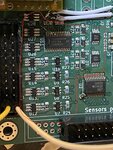andersmjorgensen
Newbie
I have run into a peculiar problem. I designed a board to include some 12 V H-bridge circuits for bidirectional control of DC motors and speed with PWM. So far so good. But some of the motors I am to drive have a common terminal. There are many many motors (hundreds perhaps) so rewiring the motors is not an option. For example I might have 4 motors sharing a common wire (5 wires total), and to drive them in arbitrary directions requires the common to be ground and to apply +12 V or -12 V to the other leads to choose direction. I want my circuit to have the capability, logic selectable via MCU GPIO pins, to drive either as a regular H-bridge, or as bipolar, because then for single-polarity situations I will not have to supply -12 V. The board contains a moderately large, 16, number of motor drivers in a tight space and I drive the PWM signal for single-polarity with a LED driver and it works well. I can think of a few ways of adding the bipolar capability, but I am looking for something that is optimal and compact, because of the space constraint. Has anyone done something like this before or have any ideas for a circuit that might work?

